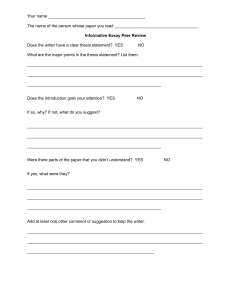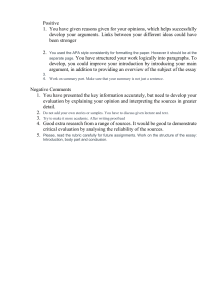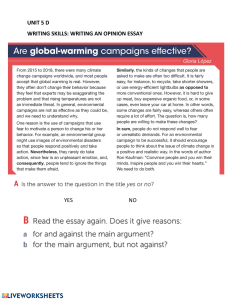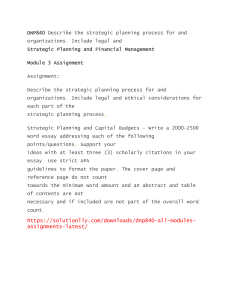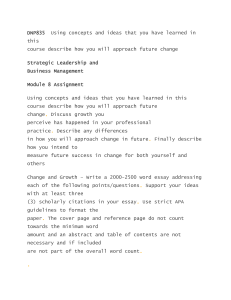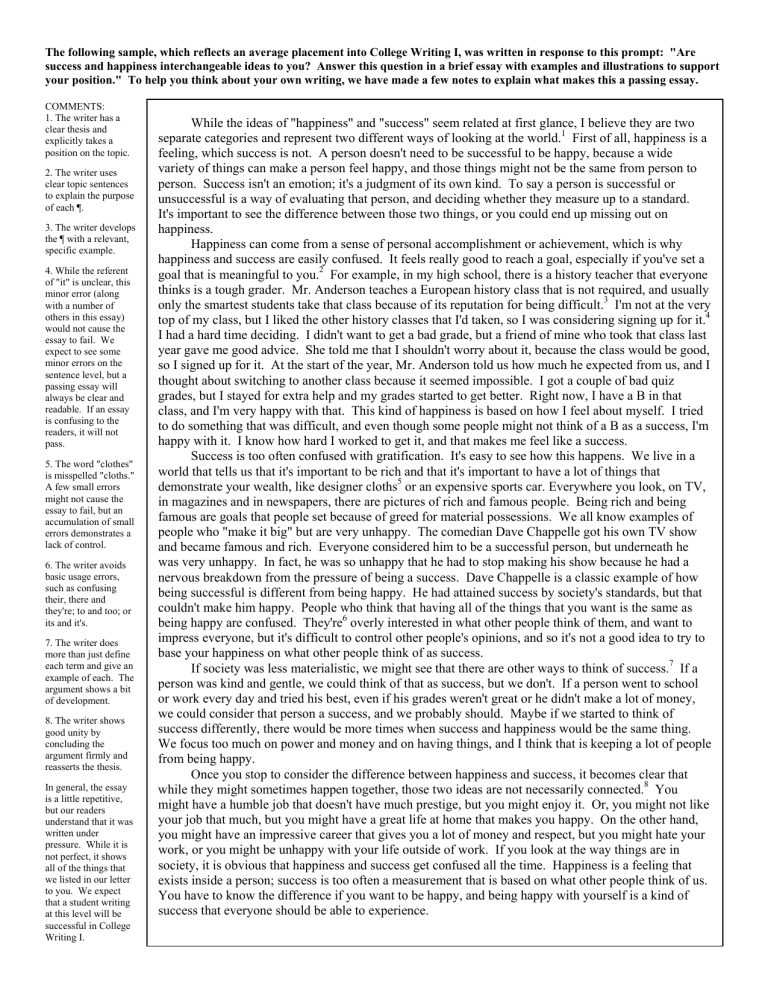
Sample Essay The following sample, which reflects an average placement into College Writing I, was written in response to this prompt: "Are success and happiness interchangeable ideas to you? Answer this question in a brief essay with examples and illustrations to support your position." To help you think about your own writing, we have made a few notes to explain what makes this a passing essay. COMMENTS: 1. The writer has a clear thesis and explicitly takes a position on the topic. 2. The writer uses clear topic sentences to explain the purpose of each ¶. 3. The writer develops the ¶ with a relevant, specific example. 4. While the referent of "it" is unclear, this minor error (along with a number of others in this essay) would not cause the essay to fail. We expect to see some minor errors on the sentence level, but a passing essay will always be clear and readable. If an essay is confusing to the readers, it will not pass. 5. The word "clothes" is misspelled "cloths." A few small errors might not cause the essay to fail, but an accumulation of small errors demonstrates a lack of control. 6. The writer avoids basic usage errors, such as confusing their, there and they're; to and too; or its and it's. 7. The writer does more than just define each term and give an example of each. The argument shows a bit of development. 8. The writer shows good unity by concluding the argument firmly and reasserts the thesis. In general, the essay is a little repetitive, but our readers understand that it was written under pressure. While it is not perfect, it shows all of the things that we listed in our letter to you. We expect that a student writing at this level will be successful in College Writing I. While the ideas of "happiness" and "success" seem related at first glance, I believe they are two separate categories and represent two different ways of looking at the world.1 First of all, happiness is a feeling, which success is not. A person doesn't need to be successful to be happy, because a wide variety of things can make a person feel happy, and those things might not be the same from person to person. Success isn't an emotion; it's a judgment of its own kind. To say a person is successful or unsuccessful is a way of evaluating that person, and deciding whether they measure up to a standard. It's important to see the difference between those two things, or you could end up missing out on happiness. Happiness can come from a sense of personal accomplishment or achievement, which is why happiness and success are easily confused. It feels really good to reach a goal, especially if you've set a goal that is meaningful to you.2 For example, in my high school, there is a history teacher that everyone thinks is a tough grader. Mr. Anderson teaches a European history class that is not required, and usually only the smartest students take that class because of its reputation for being difficult.3 I'm not at the very top of my class, but I liked the other history classes that I'd taken, so I was considering signing up for it.4 I had a hard time deciding. I didn't want to get a bad grade, but a friend of mine who took that class last year gave me good advice. She told me that I shouldn't worry about it, because the class would be good, so I signed up for it. At the start of the year, Mr. Anderson told us how much he expected from us, and I thought about switching to another class because it seemed impossible. I got a couple of bad quiz grades, but I stayed for extra help and my grades started to get better. Right now, I have a B in that class, and I'm very happy with that. This kind of happiness is based on how I feel about myself. I tried to do something that was difficult, and even though some people might not think of a B as a success, I'm happy with it. I know how hard I worked to get it, and that makes me feel like a success. Success is too often confused with gratification. It's easy to see how this happens. We live in a world that tells us that it's important to be rich and that it's important to have a lot of things that demonstrate your wealth, like designer cloths5 or an expensive sports car. Everywhere you look, on TV, in magazines and in newspapers, there are pictures of rich and famous people. Being rich and being famous are goals that people set because of greed for material possessions. We all know examples of people who "make it big" but are very unhappy. The comedian Dave Chappelle got his own TV show and became famous and rich. Everyone considered him to be a successful person, but underneath he was very unhappy. In fact, he was so unhappy that he had to stop making his show because he had a nervous breakdown from the pressure of being a success. Dave Chappelle is a classic example of how being successful is different from being happy. He had attained success by society's standards, but that couldn't make him happy. People who think that having all of the things that you want is the same as being happy are confused. They're6 overly interested in what other people think of them, and want to impress everyone, but it's difficult to control other people's opinions, and so it's not a good idea to try to base your happiness on what other people think of as success. If society was less materialistic, we might see that there are other ways to think of success.7 If a person was kind and gentle, we could think of that as success, but we don't. If a person went to school or work every day and tried his best, even if his grades weren't great or he didn't make a lot of money, we could consider that person a success, and we probably should. Maybe if we started to think of success differently, there would be more times when success and happiness would be the same thing. We focus too much on power and money and on having things, and I think that is keeping a lot of people from being happy. Once you stop to consider the difference between happiness and success, it becomes clear that while they might sometimes happen together, those two ideas are not necessarily connected.8 You might have a humble job that doesn't have much prestige, but you might enjoy it. Or, you might not like your job that much, but you might have a great life at home that makes you happy. On the other hand, you might have an impressive career that gives you a lot of money and respect, but you might hate your work, or you might be unhappy with your life outside of work. If you look at the way things are in society, it is obvious that happiness and success get confused all the time. Happiness is a feeling that exists inside a person; success is too often a measurement that is based on what other people think of us. You have to know the difference if you want to be happy, and being happy with yourself is a kind of success that everyone should be able to experience. Sample Essay (800 words) For the assignment question and analysis, see Sample essay 1 Education means considerably more than just teaching a student to read, write, and manipulate numbers. Computers, the Internet, and advanced electronic devices are becoming essential in everyday life and have changed the way information is gathered. How this new technology is utilized in the curriculum and managed by teachers will have an important role to play in widening the resource and knowledge base for all students. Technology affects the way teachers teach and students learn. To make the best use of information technology (IT), schools need a workable plan to fully integrate it into all aspects of the curriculum so students are taught how, why, and when to use technology to further enhance their learning. If a school does not have a clear plan of how and why it wishes to implement IT, then it runs the risk of wasting money. In schools today, nearly all classrooms have access to a computer. However, many schools mistake this as incorporating information technology into the curriculum. School staff need to research what IT is available and what would best serve the school's purpose, not simply purchase the latest equipment. There should be a policy stating how IT is going to assist pupils' development and what teachers want pupils to achieve (Reksten, 2000). Staff members need to be clear about what they want IT to do for them before they can start incorporating it into their lessons. The only way information technology is going to be useful to schools is if all staff members are well-informed and fully supported. It is the principal's responsibility, and should be part of the school's plan, to ensure that all staff are consulted about the changes, and that the change is carefully organised. Some teachers may be resistant, especially if they have not had much experience with computers, so training teachers is essential in implementing IT into the school curriculum. Staff members must feel involved in the process of acquiring technology, and in learning how to operate it, in order for them to increase their confidence Comment [de1]: Structure: Introductions The essay begins with a general lead into the broad topic by indicating the inadequacy of traditional teaching alone. It sets up a problem that the essay will solve. See essay introduction. Comment [de2]: Format: Spacing Essays are usually double-spaced or 1.5-line spaced. See formatting and layout. Comment [de3]: Structure: Introductions The topic is narrowed by affirming the significance of IT for teachers and students. Comment [de4]: Structure: Introductions The final sentence is the thesis statement. Notice how the beginning of the sentence is constructed to answer the essay question. It uses keywords from the question: “best use”, “information technology”, and “schools”. See essay thesis statement. Comment [de5]: Format: Abbreviations “Information technology” is followed by its abbreviated form in brackets: “(IT)”. Now that it has been defined, the abbreviation can be used elsewhere in the essay. Comment [de6]: Structure: Body paragraphs The first sentence of this paragraph is the topic sentence. It signals that the paragraph is about how schools need a clear plan for implementing IT. This point follows up on the first point made in the thesis statement: schools need a workable plan. See essay body paragraphs. Comment [de7]: Structure: Body paragraphs This statement moves into specifics; it details particular actions that a school can do to develop an IT plan. See essay body paragraphs. Comment [de8]: Referencing: In-text citation This in-text citation indicates that the idea presented in this sentence is taken from an outside source. The in-text citation gives the surname of the author (Reksten) and the year the source was published (2000). This citation uses APA style. See APA in-text citation. Comment [de9]: Structure: Body paragraphs The final sentence of the paragraph summarises and restates the idea introduced at the start of the paragraph. in using IT as a curriculum tool. Teachers are only going to be able to incorporate IT into their lessons if they are competent users themselves (Reksten, 2000). In addition, teachers need to be aware that IT within the classroom is extremely flexible, but that they need to plan what purpose IT serves in each lesson. The skills a child learns are the Comment [de10]: Referencing: Paraphrasing The idea in this sentence is taken from an outside source, as indicated by the in-text citation. The exact wording of the source has not been used, so this is a paraphrase. See paraphrasing and summarising. important part of any lesson, and it is the same with technology. IT needs to be used and understood in all subjects in the same way as the ability to read is necessary for all subjects, and “must be used across the curriculum, in the same way that a pen and pencil are used in most subject areas” (Ager, 2000, p. 15). The best way to plan the use of IT in the classroom is to approach it as simply a learning tool that is more advanced (and more exciting) than the traditional pen and paper. It is vitally important for students to be taught the strategies for using IT. Children also need to be fully informed about the capabilities of IT before being asked to use it. Pupils should be aware that the contexts in which they use IT will change, and they need to know what the appropriate use of IT is and what is not. Whilst it is important that children learn to use IT effectively, teachers must emphasise that IT is not always suitable. According to Apter (1968), the danger is that the “computer dehumanizes people and inevitably leads them to act like machines themselves” (p. 58). Teachers must make sure they plan to use variety in their lessons. Too much IT instruction may be just as harmful to a child as not enough. The usefulness of IT in the classroom, as with any learning tool, depends on the innovation and imagination of the teacher. It is imperative, though, that the implementation of IT into a school is carefully planned. The current information explosion makes it essential that IT be Comment [de11]: Referencing: Quotation The quotation marks indicate that this is taken word-for-word from an outside source. Rather than standing alone, the quotation is integrated into the sentence. The sentence begins with the student's own words, and then flows directly into the quotation. See integrating quotations with your writing. Comment [de12]: Referencing: In-text citation This in-text citation also indicates a page number. Intext citations for quotations should always have a page number, if one is available. See page numbers in APA in-text citations. Comment [de13]: Structure: Body paragraphs This topic sentence deals with the final points made in the thesis statement. It focuses on teaching students how, why, and when to use technology. Comment [de14]: Referencing: Author name When citing a source, the author's name can also appear outside the brackets as part of the sentence. The year and page number still remain within brackets. See APA in-text citation. Comment [de15]: Structure: Conclusion The conclusion reaffirms the points made in each paragraph. Together, these points support the thesis statement (the overall argument). See essay conclusion. used extensively within the classroom so children know how to use IT appropriately and effectively. Teachers must, therefore, be fully informed about what kinds of IT are available and whether or not they are appropriate for classroom use. School boards and teachers must therefore ensure that all staff have a clear plan about what they want their students to achieve through IT. The appropriate incorporation of IT into the classroom will broaden the minds and skills of students, allowing them to be better prepared for further technological advances. References Ager, R. (2000). The art of information and communications technology for teachers. David Fulton. Apter, A. J. (1968). The new technology of education. Macmillan. Reksten, L. E. (2000). Using technology to increase student learning. Corwin Press. Comment [de16]: Format: Heading Short essays do not need headings or sub-headings. The exception is the reference list: this section should be identified with a heading. See APA reference list. Comment [de17]: Referencing: Reference list The reference list at the end of the assignment gives more detail about all of the sources used in the assignment. The author's name and the year of publication always come first. See APA reference list. Comment [de18]: Referencing: Reference list After the author's name and the year, each entry shows the publication details - for books, this includes the title and publisher name. The title of the book is always in italics for APA Style. See APA reference list. Comment [de19]: Format: Hanging indent Each entry in the reference list has a hanging indent. This means that every line after the first is indented (moved a few spaces to the right).

